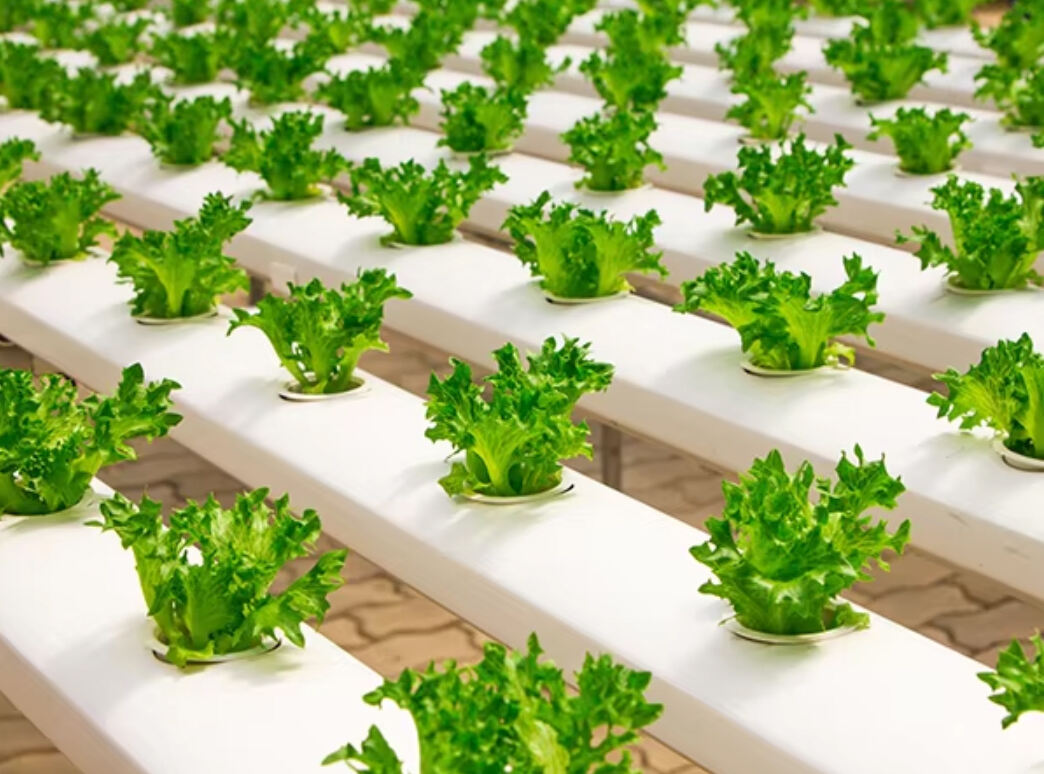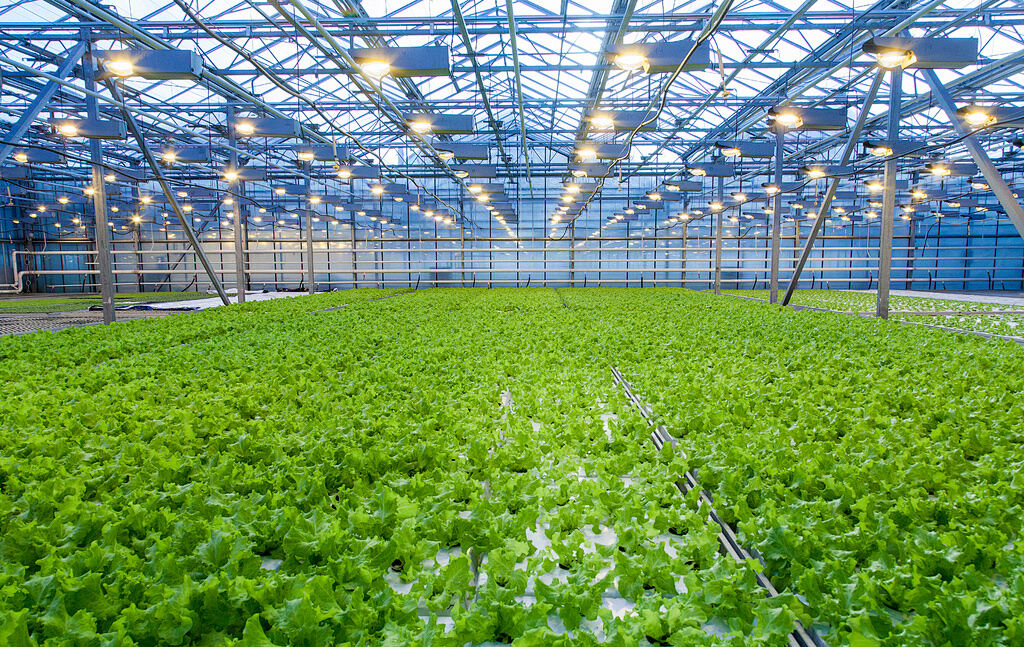Best Crops for Hydroponics by Growth Difficulty
Beginner-Friendly Hydroponic Crops (e.g., Lettuce, Herbs, Strawberries)
Lettuce and spinach make great starter plants because they grow so fast, usually ready to harvest within around 21 to 30 days, and don't need much attention once established. They work really well in systems that accommodate shallow roots, especially those using Nutrient Film Technique or NFT for short. With this method, nutrients keep flowing steadily over the roots which helps leaves develop quickly. Basil and mint plants tend to do pretty good too, sometimes even growing about 30 percent quicker compared to what happens in regular garden soil. Strawberries are another solid choice for folks just starting out with hydroponics. When planted vertically, these berries can produce all year long if the water has a pH between roughly 5.8 and 6.2, while electrical conductivity should stay somewhere around 1.2 to 1.6 mS per cm. What's nice about strawberries is how they handle small changes in nutrient levels without getting upset, making them quite forgiving for someone who might still be learning the ropes.
Intermediate-Level Hydroponic Crops (e.g., Bok Choy, Celery, Tomatoes)
For bok choy and celery, getting that calcium to magnesium ratio right at around 2 to 1 is pretty important if we want to avoid those pesky tip burns. Tomatoes tell a different story altogether they really crave that intense light, about 14 to 18 hours each day, plus some good old fashioned trellising to keep those vines from going wild. When it comes to DWC systems, most growers find that keeping dissolved oxygen levels somewhere between 6 and 8 ppm works best for healthy roots during the fruiting stage. And here's something interesting about celery grown hydroponically with proper care, it tends to produce roughly 20 to 25 percent more than what comes out of regular soil gardens throughout its typical 70 to 90 day growing period.
Advanced Hydroponic Crops (e.g., Broccoli, Peppers, Blueberries)
Broccoli plants are pretty picky when it comes to temperature fluctuations, they really struggle if conditions drift more than 2 degrees Fahrenheit away from what's ideal. Peppers present their own challenges too, needing careful nutrient management especially when they start flowering periods where potassium levels need boosting. Blueberry cultivation gets even trickier since these berries thrive best in soil with acidity levels between 4.5 and 5.5 on the pH scale. Growers often have to supplement with specific forms of iron because regular fertilizers just don't cut it for blueberries. And let's not forget that establishing blueberries in aeroponic systems takes patience, sometimes stretching out over three full growing seasons before things settle down. Looking at recent industry trends, commercial pepper operations that implement automatic pH control systems see about an 18 percent boost in crop output according to AgriTech research from last year.
Other Suitable Plants for Hydroponics (e.g., Green Onions, Mustard Greens)
Green onions regenerate from cuttings in just 14–21 days and use 40% less water than traditional farming. Mustard greens tolerate a broad pH range (5.5–6.8) and produce elevated levels of glucosinolates—their signature bioactive compounds—under targeted LED lighting. These resilient plants integrate seamlessly into multi-tiered hydroponic systems, enhancing overall productivity.
Leafy Greens in Hydroponics: Why Lettuce and Spinach Excel
Lettuce Growth Cycle and Nutrient Uptake in Hydroponic Systems
Lettuce matures in 25–30 days with a shallow root system that efficiently absorbs nutrients in NFT or DWC setups. A balanced solution containing 8–12% nitrogen, 4–6% potassium, and 3–5% phosphorus promotes vigorous leaf growth. Maintaining stable pH (5.5–6.5) and EC (1.2–2.0 mS/cm) enables hydroponic lettuce to grow 20% faster than in soil.
Optimal Growing Conditions for Hydroponic Crops Like Spinach and Arugula
Spinach reaches peak flavor and yield at 60–70°F under 12–14 hours of daily light, whereas arugula prefers slightly warmer temperatures (65–75°F). These greens require 30% less magnesium in hydroponic systems compared to soil, making them highly efficient for controlled environment agriculture.
| Parameter | Spinach | Arugula |
|---|---|---|
| Ideal pH | 6.0-7.0 | 6.2-6.8 |
| EC Range | 1.8-2.4 mS/cm | 1.4-2.0 mS/cm |
| Harvest Time | 35-40 days | 25-30 days |
Comparative Yield Data: Hydroponic vs. Soil-Grown Leafy Greens
Hydroponic systems generate three times more lettuce per square foot annually—18 harvests versus 6 in soil—while using significantly less water. Spinach yields increase by 25–30% in DWC systems, which consume 90% less water than conventional methods. Nutrient retention improves too: hydroponic greens show 12–15% higher iron content and 8–10% more vitamin C.
Herbs and Flavorful Crops: Growing Basil, Mint, and Cilantro Hydroponically
Herbs (Basil, Mint, Parsley) as High-Value Hydroponic Crops
When it comes to growing herbs hydroponically, basil, mint, and parsley stand out as some of the better money makers because they grow quickly and sell for good prices at markets. Basil does best when getting around 14 to maybe even 16 hours of light each day, and usually gets ready for picking within about three weeks give or take a few days. Mint plants tend to do really well in NFT systems since their roots just keep spreading out all over the place. Parsley is another solid choice that keeps producing decent amounts without needing too many nutrients, making it suitable for folks running either tiny home setups or bigger commercial vertical farming operations.
Basil Production in Hydroponics: Nutrient Requirements and Harvest Frequency
During vegetative growth, hydroponic basil needs 150–200 ppm nitrogen, shifting toward higher phosphorus during flavor development. Regular pruning every 21–28 days encourages branching and allows for six to eight harvests per year per plant. Keeping water temperatures between 68–72°F prevents root rot and maximizes nutrient uptake.
Cilantro for Hydroponic Farming: Challenges and Best Practices
Cilantro’s heat sensitivity requires strict climate control (60–75°F) and good air circulation. Using rockwool cubes in DWC systems stabilizes delicate stems, while weekly staggered planting ensures continuous harvests. To avoid leaf tip burn, maintain calcium levels above 100 ppm and keep EC between 1.8–2.3.
Do Hydroponic Herbs Lack Flavor Compared to Soil-Grown? Debunking the Myth
Contrary to popular belief, optimized hydroponic conditions enhance herb flavor. Studies show hydroponic basil contains 12–18% more essential oils—like linalool and eugenol—than soil-grown plants. By adjusting light spectra (including 30% blue light to boost terpene synthesis) and minimizing nutrient stress, growers achieve superior aroma, taste, and shelf life.
Fruiting Crops in Hydroponic Systems: Tomatoes and Strawberries
Tomatoes in Hydroponic Farming: Supporting Vining Growth and Fruit Load
Indeterminate tomato varieties excel in hydroponic environments with trellising support and precise nutrient control. Potassium-rich solutions (12–14% of total NPK) promote fruit development, while reduced root competition leads to 20–30% higher fruit mass compared to soil cultivation.
Strawberries in Hydroponic Farming: Disease Prevention and Vertical Stacking
Vertical hydroponic systems improve airflow around strawberry plants, reducing risks of fungal diseases such as Botrytis. Stacked NFT channels increase yield by 40% per square foot over soil beds. Automated pH monitoring within the 5.8–6.2 range helps prevent calcium deficiencies and supports consistent fruit quality.
Nutrient Requirements of Hydroponic Plants During Flowering and Fruiting Stages
Fruiting crops require dynamic NPK adjustments throughout their lifecycle:
| Growth Stage | Nitrogen | Phosphorus | Potassium |
|---|---|---|---|
| Vegetative | 18% | 6% | 12% |
| Flowering | 8% | 14% | 20% |
EC should rise from 1.8–2.2 mS/cm in vegetative stages to 2.4–2.8 mS/cm during fruit maturation to facilitate sugar accumulation.
Case Study: Commercial Strawberry Yield Increase Using NFT Hydroponic System
A 5-acre farm switched from drip irrigation to NFT channels and achieved a 63% reduction in water usage, 28% faster harvest cycles (42 vs. 54 days), and a 19% increase in brix levels. Continuous root oxygenation minimized transplant shock and enabled year-round production under LED lighting.
Root Structure and System Compatibility in Hydroponic Crop Selection

Root Structure and Plant Suitability for Hydroponics: Shallow vs. Deep Root Systems
Crop success in hydroponics depends on root architecture. Shallow-rooted plants like lettuce and herbs flourish in NFT systems, where roots access a constant flow of nutrient-rich film. This design supports 15–20% faster growth compared to soil (Ponemon 2023), as their compact root systems efficiently absorb dissolved minerals.
Deep-rooted crops such as tomatoes and peppers require robust support and oxygenation, best provided by DWC or drip systems. Research shows tomato root biomass grows 40% thicker in DWC than in NFT, enhancing nutrient uptake and fruit yield.
How Hydroponic System Types (NFT, DWC, Drip, Aeroponics) Affect Root Health
System choice directly influences oxygen availability, pH stability, and disease risk:
| System Type | Oxygen Delivery | Ideal Crops | Root Health Risk |
|---|---|---|---|
| NFT | Moderate | Lettuce, spinach | Clogging from sediment |
| DWC | High | Tomatoes, peppers | Algae growth |
| Aeroponics | Maximum | Herbs, strawberries | Dry-out during outages |
With aeroponic setups, those hanging roots get misted roughly every five to ten minutes, which boosts their oxygen intake around seventy percent more than what we see in DWC systems according to research from the University of Arizona's Hydroponics Lab back in 2023. That kind of extra oxygen makes all the difference when growing crops that tend to catch diseases easily. Looking at other methods, nothing beats NFT for leafy greens that grow quickly. Gardeners can expect anywhere from twelve harvests annually using NFT versus just four to six times if they stick with traditional soil cultivation. When it comes to fruits though, DWC seems to hit that sweet spot where plants actually stand upright while still getting enough air. Tomato lovers will notice the difference too since these hydroponically grown tomatoes pack about thirty percent more sugar than their earth-bound counterparts, making them noticeably sweeter on the palate.
FAQ
What are the best crops to start with in hydroponics?
Beginner-friendly crops include lettuce, herbs like basil and mint, and strawberries due to their fast growth and forgiving nature in terms of nutrient fluctuations.
Why are strawberries suitable for beginner hydroponic growers?
Strawberries can adapt well to small changes in nutrient levels and can produce all year round when planted vertically in hydroponic systems.
What conditions do tomatoes need to thrive in hydroponic systems?
Tomatoes require intense light (14-18 hours daily), trellising support, and a potassium-rich nutrient solution for optimal fruit development.
How do hydroponic herbs compare to soil-grown in terms of flavor?
Optimized hydroponic conditions can enhance flavor, leading to higher levels of essential oils like linalool and eugenol compared to soil-grown herbs.
What system types are best for different root structures?
Shallow-rooted crops like lettuce and herbs perform well in NFT systems, while deep-rooted crops like tomatoes and peppers thrive in DWC or drip systems.
Table of Contents
- Best Crops for Hydroponics by Growth Difficulty
- Leafy Greens in Hydroponics: Why Lettuce and Spinach Excel
- Herbs and Flavorful Crops: Growing Basil, Mint, and Cilantro Hydroponically
-
Fruiting Crops in Hydroponic Systems: Tomatoes and Strawberries
- Tomatoes in Hydroponic Farming: Supporting Vining Growth and Fruit Load
- Strawberries in Hydroponic Farming: Disease Prevention and Vertical Stacking
- Nutrient Requirements of Hydroponic Plants During Flowering and Fruiting Stages
- Case Study: Commercial Strawberry Yield Increase Using NFT Hydroponic System
- Root Structure and System Compatibility in Hydroponic Crop Selection
-
FAQ
- What are the best crops to start with in hydroponics?
- Why are strawberries suitable for beginner hydroponic growers?
- What conditions do tomatoes need to thrive in hydroponic systems?
- How do hydroponic herbs compare to soil-grown in terms of flavor?
- What system types are best for different root structures?


